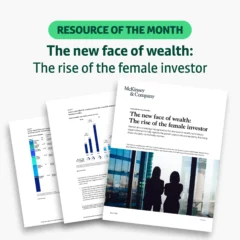 In 2021, the State Bank of Pakistan––which regulates Banks, Development Finance Institutions (DFIs), Exchange Companies and Microfinance Banks in the country––introduced the Banking on Equality (BoE) Policy, the first comprehensive, national-level gender mainstreaming policy framework among regional peers.
In 2021, the State Bank of Pakistan––which regulates Banks, Development Finance Institutions (DFIs), Exchange Companies and Microfinance Banks in the country––introduced the Banking on Equality (BoE) Policy, the first comprehensive, national-level gender mainstreaming policy framework among regional peers.
The initiative has delivered measurable progress across key metrics for women’s financial inclusion including increasing the number of women with active accounts from 20 million to 35 million. Building on this foundation, the State Bank of Pakistan launched the WE Finance Code Pakistan on July 7, with the aim of focusing on financing Pakistan’s burgeoning female entrepreneur market.
In this interview, we speak with Mr. Abid Qamar, Director of Agriculture Credit & Financial Inclusion at the State Bank of Pakistan, about how Banking on Equality transformed the sector, the strategic thinking behind introducing the WE Finance Code, and the vision for where BoE 2.0 will take the country’s financial landscape.
Alliance: For the benefit of our global audience, can you please give a brief overview of the policy goals and main policies laid out in the Banking on Equality (BoE) policy framework?
Mr. Abid Qamar (AQ): Banking on Equality is Pakistan’s first gender mainstreaming policy. As the first policy of its kind, it comprehensively recognizes the wide-ranging demand and supply side factors that lead to the gender gap in finance, including lack of awareness, social norms, and mobility constraints. The Policy tackles these challenges through a comprehensive approach that centers on embedding a gender lens in the policies and practices of the banks to improve their orientation towards serving women. It challenged the pre-existing gender-neutral mindset in policies and practices of financial institutions, while launching Pakistan on a journey of being gender intentional in our approaches.
The Policy identifies the following five key pillars, under which actions are targeted towards improving institutional readiness, product diversification and development capability, customer acquisition and facilitation approaches towards women segments, and enhanced collection and monitoring of gender disaggregated data:
- Improving Gender Diversity in Financial Institutions and their Access Points: Under this pillar, banks were instructed to improve the ratio of women in the workforce from 13 percent to 20 percent by 2024, and ensure that at least one woman is on their board. Moreover, banks were also instructed to ensure women’s ratio as branchless banking agents improves from 1 percent to 10 percent by 2024.
- Women centric products and services and outreach targets: Banks were instructed to establish a “Women’s Financial Services Department” to ensure a dedicated team is in place to analyze market opportunities and develop new products for women’s needs across various life cycle stages. The banks were also given targets to improve their outreach in women’s share in bank accounts, Agri and micro/SME finance, which were monitored on a quarterly basis.
- Women Champions at Access Points: To improve women’s facilitation at bank branches, banks were instructed to place women champions at 75 percent of their touch points. Bank were also instructed to ensure all staff goes through gender sensitivity training to remove unconscious biases towards women and create a gender friendly environment for customers and staff members.
- Robust collection of Gender-disaggregated data and target setting: We introduced a wider and deeper scope of gender disaggregated data collection and regularly collected data from banks on a range of parameters.
- Lastly, to bring a gender focus in further policy formulation, a Policy Forum on Gender and Finance was established. It was chaired by Governor SBP and had representation from public and private sector entities
Alliance: What was the original inspiration for developing the Banking on Equality policy? How did the idea first take shape and why was it adopted?
AQ: Before the launch of BoE policy in 2021, the level of women’s financial inclusion was quite low:
- Over 24 million adult women had at least one bank account or mobile wallet, translating into 38 percent of women financially included.
- Just 13 percent of financial institutions’ staff were women.
- Women were not considered as a viable business segment for financing.
This was due to both demand- and supply-side issues. On the demand side, social and cultural constraints, such as low mobility, limited land ownership, and lack of financial literacy, restricted women from accessing formal financial services. On the supply side, the banks and financial institutions’ policies, products, and services and distribution strategies have traditionally been male-centric, gender neutral at best, and not positively biased towards women.
Against that backdrop, SBP introduced a comprehensive ‘Banking on Equality Policy,’ which is the first gender mainstreaming policy envisioned by any central bank in the South Asia region to make financial institutions adopt a holistic and mindful incorporation of gender perspectives in their policies. With the launch of the BoE Policy, SBP introduced a systematic and coordinated approach to improve women’s financial inclusion. The approach was based on an in-depth gender-disaggregated data analysis to understand what needs to be done to reduce the rising gender gap in financial inclusion. Further, it was realized that it is imperative for policymakers to not remain gender neutral anymore; rather, a gender-intentional approach is necessary to close the gender gap.
Alliance: What are the results to date of BoE both in terms of financial inclusion of women and on inclusion of women in the workforces of financial services providers that you regulate?
AQ: I am pleased to share that after 3 years of implementation the policy has reaped positive results. The key achievements made under the policy as of December 2024 are as follows:
- Banks have hired over 13 thousand women and improved the ratio of women staff from 13 percent to 17 percent; during this time, women’s hiring grew by 43 percent, compared to men’s hiring growing by 9 percent.
- Women Active Accounts have increased from 20 million to 35 million, registering a 70 percent growth.
- Microfinance lending grew from 912K women borrowers to over 3M women borrowers in three years.
- 81 percent of bank branches have dedicated women champions in place.
- 83 percent of overall bank staff has been imparted gender sensitivity trainings.
- All banks have appointed female directors to their Boards, formed Diversity & Inclusion Councils or management sub-committees on gender, and established dedicated women’s financial services departments/teams.
As a result of these initiatives, the gender gap in financial inclusion has narrowed by 5 percent, from 39 percent in 2021 to 34 percent in 2024.
Alliance: Why was/is it important to include workforce diversity in the BoE policy?
AQ: Diversity is one of the prerequisites for an inclusive and sustainable financial system. A financial institution cannot adequately address the female market segment without addressing its internal gender imbalance, as workforce diversity is important for fostering a healthy work culture, diversity of ideas, improving facilitation of women customers and recognizing women’s contribution to economic development.
Under the policy, the financial service providers were advised to develop policies to improve gender diversity at each level, i.e., entry level, management level, and more importantly, at the board level, so the gender lens can be embedded not only at the strategic and policy-making level but also at the enforcement level. Accordingly, banks were advised to make new management subcommittees on gender to include a focus on this area. Furthermore, gender diversity targets for all C-suite executives were adopted and embedded in their KPIs to improve women’s representation in senior management.
These measures were also essential to bring about a mindset shift where now we have seen that in the past 3 years, women comprised 40 percent of new hiring at banks. We are witnessing more women-friendly initiatives being rolled out; for example, a few banks have self-initiated “return-ship programs” to encourage women who have taken a career break to rejoin the workforce. So, we are seeing the policy working exactly as we hoped.
Alliance: Earlier this month, SBP together with the ADB launched the WE Finance Code Pakistan, with the aim of catalyzing financing for women entrepreneurs. How will the Code build on the progress already made through the BoE?
AQ: SBP is cognizant of the fact that despite the progress in women’s financial inclusion through bank account ownership, their access to finance is still very limited and women continue to face challenges and find it difficult to obtain financing for their businesses. Currently, only one out of every five borrowers is a woman, indicating that only 20 percent of adult women borrow from banks.
Therefore, now we are developing the second iteration of the BoE Policy and a key component of BoE 2.0 will be to improve women’s access to financing. Our motivation to adopt the WE Finance Code ties in with this.
I am happy to share that since we launched the Code, 22 banks (including fourteen commercial and six microfinance banks) and have joined the Code, as has the Pakistan Banks Association, and we are expecting more coalition partners as well. The Code signatories have pledged to introduce new actions, share data, and appoint leadership at banks to improve women’s access to finance in the country. We are fortunate to have Asian Development Bank (ADB) as a technical partner for implementation of the Code in the country.
Going forward, to ensure strong cross-industry support, we are developing a national charter that will formally establish the National WE Finance Code Coalition. All code signatories will become part of the National Code Coalition which will comprise of policy makers, regulators, and the financial service providers, who will work in a collaborative manner to take strategic actions for increasing women’s access to financing.
Alliance: How has SBP’s collaboration with the Financial Alliance for Women (for example, on developing the national gender data dashboard) helped to support your women’s financial inclusion efforts?
AQ: Becoming a WE Finance code signatory brings the opportunity to get access to international industry experts dedicated to championing the Female Economy and supplies key market insights that are incredibly useful for the financial sector providers of any country.
SBP was fortunate to give its banks the experience of the All Stars Academy in 2022, which is one of FAFW’s most valuable programs. Our bankers learned from experienced guest experts in other countries about how they were able to develop women-centered strategies and successfully tap into the Female Economy. This exposure helped the banks understand how to best comply with the BoE Policy instructions and supported their abilities to develop demand-centered, tailored products for women customers.
In addition, FAFW and ConsumerCentriX also bring competencies of developing data dashboards and analytics tools. This is not only essential for policy making but also for financial service providers to visualize gender disaggregated data effectively to determine existing market gaps and opportunities. In recognition of these benefits, SBP is in the process of developing a dashboard which will support the FSPs to advance women’s financial inclusion.



